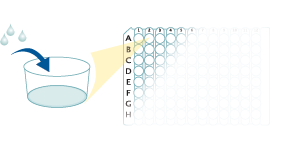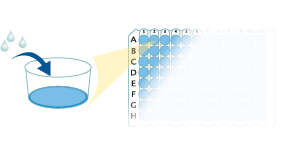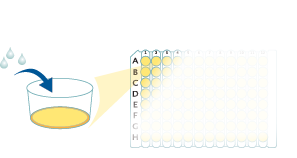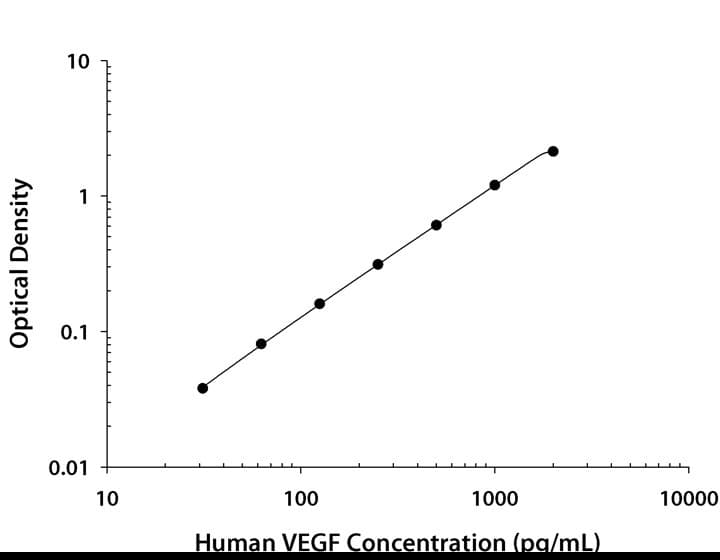



 下载产品说明书
下载产品说明书 下载SDS
下载SDS 用小程序,查商品更便捷
用小程序,查商品更便捷



 收藏
收藏
 对比
对比 咨询
咨询Product Summary
Sample Values
Serum/Plasma - Samples from apparently healthy volunteers were evaluated for the presence of human VEGF in this assay. No medical histories were available for the donors used in this study.| Sample Type | Mean of detectable (pg/mL) | % Detectable | Range (pg/mL) |
| Serum (n=37) | 220 | 100 | 62-707 |
| EDTA plasma (n=37) | 61 | 24 | ND-115 |
| Heparin plasma (n=37) | 41 | 22 | ND-55 |
| Citrate plasma (n=37) | ___ | 0 | ND |
Recovery
The recovery of human VEGF spiked to three different levels throughout the range of the assay in various matrices was evaluated.
| Sample Type | Average % Recovery | Range % |
|---|---|---|
| Cell Culture Media (n=5) | 102 | 95-111 |
| Citrate Plasma (n=5) | 100 | 88-113 |
| EDTA Plasma (n=5) | 97 | 82-113 |
| Heparin Plasma (n=5) | 93 | 82-102 |
| Serum (n=5) | 102 | 92-115 |
Linearity
Scientific Data
Assay Procedure
Refer to the product datasheet for the complete assay procedure.
Bring all reagents and samples to room temperature before use. It is recommended that all samples, standards, and controls be assayed in duplicate.
- Prepare all reagents, standard dilutions, and samples as directed in the product insert.
- Remove excess microplate strips from the plate frame, return them to the foil pouch containing the desiccant pack, and reseal.
- For Serum & Plasma Samples: Add 100 µL of Assay Diluent to each well.
For Cell Culture Supernate Samples: Add 50 µL Assay Diluent to each well. - For Serum & Plasma Samples: Add 100 µL of Standard, control, or sample to each well. Cover with a plate sealer, and incubate at room temperature for 2 hours.
For Cell Culture Supernate Samples: Add 200 µL of Standard, control, or sample to each well. Cover with a plate sealer, and incubate at room temperature for 2 hours. - Aspirate each well and wash, repeating the process twice for a total of 3 washes.
- Add 200 µL of Conjugate to each well. Cover with a new plate sealer, and incubate at room temperature for 2 hours.
- Aspirate and wash 3 times.
- Add 200 µL Substrate Solution to each well.
- For Serum & Plasma Samples: Incubate at room temperature for 25 minutes. PROTECT FROM LIGHT. For Cell Culture Supernate Samples: Incubate at room temperature for 20 minutes.
PROTECT FROM LIGHT. - For Serum & Plasma Samples: Incubate at room temperature for 25 minutes. PROTECT FROM LIGHT. For Cell Culture Supernate Samples: Incubate at room temperature for 20 minutes.
PROTECT FROM LIGHT.
Add Assay Diluent

Add Standard, Control, or Sample

200 µL Conjugate

200 µL Substrate Solution

50 µL Stop Solution

Human VEGF Quantikine ELISA Kit Summary

Background: VEGF
Vascular endothelial growth factor (VEGF or VEGF-A), also known as vascular permeability factor (VPF), is a potent mediator of both angiogenesis and vasculogenesis in the fetus and adult (1-3). It is a member of the PDGF family that is characterized by the presence of eight conserved cysteine residues in a cystine knot structure and the formation of antiparallel disulfide-linked dimers (4). Humans express alternately spliced isoforms of 121, 145, 165, 183, 189, and 206 amino acids (aa) in length (4). VEGF165 appears to be the most abundant and potent isoform, followed by VEGF121 and VEGF189 (3, 4). Isoforms other than VEGF121 contain basic heparin-binding regions and are not freely diffusible (4). Human VEGF165 shares 88% aa sequence identity with corresponding regions of mouse and rat VEGF. VEGF is expressed in multiple cells and tissues including skeletal and cardiac muscle (5, 6), hepatocytes (7), osteoblasts (8), neutrophils (9), macrophages (10), keratinocytes (11), brown adipose tissue (12), CD34+ stem cells (13), endothelial cells (14), fibroblasts, and vascular smooth muscle cells (15). VEGF expression is induced by hypoxia and cytokines such as IL-1, IL-6, IL-8, oncostatin M, and TNF-alpha (3, 4, 9, 16). VEGF isoforms are differentially expressed during development and in the adult (3).

Preparation and Storage
参考图片










 危险品化学品经营许可证(不带存储) 许可证编号:沪(杨)应急管危经许[2022]202944(QY)
危险品化学品经营许可证(不带存储) 许可证编号:沪(杨)应急管危经许[2022]202944(QY)  营业执照(三证合一)
营业执照(三证合一)